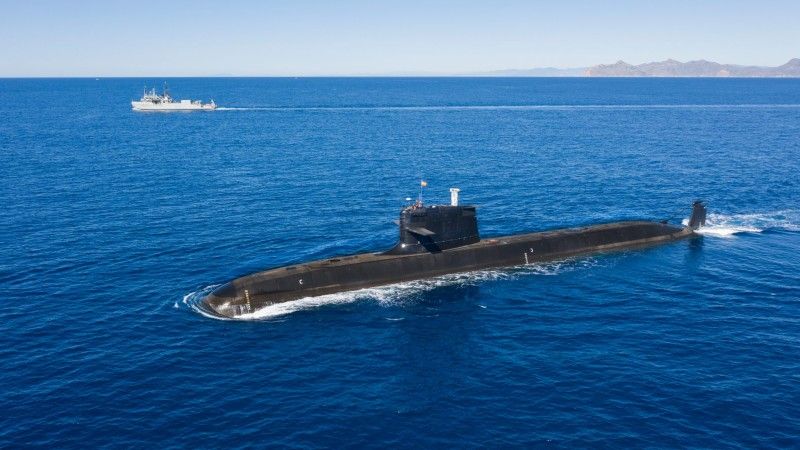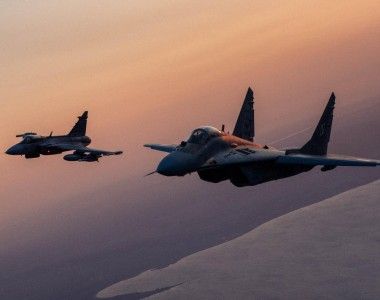Diesel to Digital: Spain's submarine force enters a new era [INTERVIEW]

Photo. Navantia
Having served on older-generation diesel-electric submarines, Commander Fernando Aguirre Pastor will soon take command of Narciso Monturiol, a brand new S-80 Plus-class boat of the Spanish Navy (Armada), which will soon enter sea trials off Cartagena.
Defence24 Days, Central and Eastern Europe’s largest defence and security conference, is a priceless opportunity to meet service members from around the world. Among the guests of this year’s edition was Commander Fernando Aguirre Pastor of the Spanish Navy (Armada), a highly experienced submariner with many years of service on diesel-electric boats. He was also delegated to the French Navy (Marine nationale) on an exchange programme, serving on two nuclear attack subs.
Read more
Commander Aguirre was responsible for the working up, training and certification of the crew of Isaac Peral (S-81), the first S-80 Plus-class diesel-electric submarine of the Armada. He also oversaw the development of the S-80 Plus integrated combat system. Today he is preparing for the launch of Narciso Monturiol (S-82), the second boat of its class. The seasoned Spanish officer will be the CO of the brand new submarine for the duration of the sea trials. We sat down for a conversation on the sidelines of Defence24 Days.
Joining the Spanish Navy
Antoni Walkowski, Defence24.pl: Before we discuss the modern Spanish submarine programme, I would like to ask you about your background. How did a young man from Cartagena become a submariner in the Armada?
Commander Fernando Aguirre Pastor, Spanish Navy: I joined the Naval Academy in 1997, full of enthusiasm, driven by a passion for the sea, inspired by my parents and a family with military traditions. While at the Naval Academy, I discovered submarines and was deeply impressed by their military capabilities and by life on board a submarine. It is a life of camaraderie and simplicity, where many experiences are shared over extended periods in a very confined space. A submarine’s ability to operate undetected, without altering maritime activity patterns, and its capacity to deter even powerful naval forces with vast military resources simply through its presence in an operational area, truly stood out to me.
Throughout my career, I have served on many different submarines: Delfín-class (Daphné-class in France), Galerna-class (Agosta), Rubis-class (a French nuclear attack submarine, where I was embarked for two years as an exchange officer), and on the S-80, where I was responsible for the Combat System. Serving on these four different classes of submarines, with technologies spanning over 40 years, with both conventional and nuclear propulsion systems, has given to me a broad understanding of the strengths and limitations of each and a clear vision of what we should expect from the S-80.

Photo. Navantia
You served as the XO of Tramontana (S-74), later becoming the CO of Mistral (S-73). Both are Galerna-class submarines built in your hometown. While we are on the subject of strengths and weaknesses, what are the limits of older diesel-electric boats in the modern era?
The fundamental quality of a submarine is stealth. Simply by its ability to navigate while submerged, remain undetected, and launch heavyweight torpedoes, both submarines fulfilled the mission they were designed for – deterrence. However, a modern vessel can significantly reduce its indiscretion rate thanks to greater battery capacity, improved energy storage, increased electrical efficiency, and being much quieter than submarines from the 1980s. Modern sensors with advanced signal processing, which allow earlier detection, more accurate classification and the ability to track hundreds of contacts through multiple sensors and engage several of them simultaneously with great versatility and weapons capability, make a great difference between these two type of submarines.
These systems, along with automated processes that significantly reduce human intervention and high platform stability and manoeuvrability, make it difficult to compare 1980s technology with that of today. Although modern submarines carry out the same mission as their predecessors, they are far more capable and effective.
A jump into the 21st Century
What are the biggest differences in terms of capability between legacy submarines and modern, AIP-equipped SSKs (or SSPs, as per U.S. Navy nomenclature)?
As I mentioned earlier, the main quality of a submarine is stealth, and its greatest strength lies in its ability to operate without being detected. To achieve this, it is essential to maintain acoustic, electromagnetic, and visual discretion. Technologies such as AIP (Air-Independent Propulsion) significantly reduce the submarine’s dependence on the atmosphere, and therefore its acoustic and visual indiscretion, since it does not need to use the diesel engines and raise the snorkelling mast to recharge the batteries.
Conventional submarines are approaching the operational profile of nuclear-powered submarines, although with less mobility, which is the ability to travel at high speeds, as well as smaller weapons carrying capacity due to its lower displacement. AIP allows submarines to perform operations without interruptions to recharge batteries.
The Spanish Navy’s primary areas of interest are the Atlantic Ocean and the Mediterranean Sea. How can a submarine be optimised for two very different operating environments?
A submarine’s operational area is determined by three key factors: the distance from its home port, the temperature of the seawater, and the seabed profile (deep or shallow waters). Since a submarine’s areas of operation can change throughout its life cycle, modern submarines must be capable of adapting their operation profile to the mission. This requires a large storage capacity for provisions and fuel, as well as the ability to operate in both cold and warm waters, and in very shallow waters.
The Spanish Navy, in fact, included in its operational requirements that the S-80 needed to be an ocean-going submarine, capable of remaining at sea for up to 45 days without needing to return to port, able to operate in both cold and warm seas and in any kind of seabed profile, even in very shallow waters. Its trimming envelope should allow to navigate in waters with very low salinity, such as the Baltic Sea, and highly saline waters like the Mediterranean sea. The platform’s stability was one of the key elements of the program. We needed a versatile submarine capable of adapting to the changing geopolitical landscape.

Photo. Navantia
What were the primary requirements in the S-80 Plus programme? What sort of capabilities do these boats have?
Consistent with its long-standing naval tradition, the Spanish Navy needed an ocean-going submarine, with powerful and rapid electricity generation, great redundancy, low acoustic and magnetic signature, good manoeuvrability, high degree of automation, reduced crew, high operational availability, strong anti-submarine and anti-surface capabilities, high degree of stealth and specifically designed for coastal operations. To achieve this, the Navy selected some of the most prestigious armament companies in the world, whose equipment and sensors were integrated into three third-generation cores: the Integrated Platform Control System, the Combat System, and the ICCS-5 Communications System.
The Isaac Peral-class will have a long operational life. How do you prepare these submarines for future upgrades?
Technology is advancing by leaps and bounds. Over the past 20 years, we have experienced an unprecedented technological revolution and submarines must be capable of adapting their sensors and data processing capabilities throughout their life cycle. The Navy has established a dedicated office for the life cycle of the S-80, which, in addition to overseeing submarine maintenance, focuses part of its efforts on planning the evolution of the S-80’s sensors and network systems.
Getting ready for sea trials
You were involved in the development of the S-80 Plus combat system. What were the primary challenges in this task? Can you disclose what kind of capabilities the Isaac Peral-class offers in this regard?
The Galerna-class (S-70) submarines did not have a Combat System and only featured a hull-mounted sonar with a limited number of hydrophones. The Navy acquired a submarine equipped with four hull-mounted sonars and a towed linear array, which multiplied the number of hydrophones by dozens compared to the S-70. These improvements enhanced the antenna directivity index and significantly increased the sonar frequency operating range, thereby improving classification capabilities. The S-80 is able to detect earlier and classify more effectively.
We faced a major challenge in terms of how to manage and exploit such a large amount of information on board, and to do so in an efficient and straightforward manner. We needed to write operational and platform procedures from scratch, test them in simulators, and train the first crew of the S-81. It was necessary to change the way we operated the S-70 submarines and take full advantage of the S-80’s capabilities. That’s where I focused my efforts during my first two years as the Combat System Officer.
In addition to the inherent capabilities of each sensor, the S-80 stands out for several algorithms capable of fusing tracks of the same contact detected by different sensors and calculating target data for up to 1,000 simultaneous tracks, thanks to a patented algorithm developed by Lockheed Martin. The ability of the combat system core to manage and present information received from various sensors for fast and effective decision-making is especially noteworthy.

Photo. Navantia
You have been designated the CO Narciso Monturiol (S-82) for the duration of the sea trials. What kind of preparations do you need to make in anticipation of the shakedown?
My preparation has consisted of thorough training in general knowledge of the platform and specific hands-on training in platform operation and Combat System simulators. My current efforts are focused on certifying the S-82 crew to operate the submarine during sea trials and to be prepared to supervise the submarine during port duties.
This training began a year ago, and the S-82 crew has had the opportunity to sail aboard the S-81 during this time, which will make their adaptation much easier. The S-81 has accumulated more than 150 days at sea and nearly 2,000 hours submerged. The Navy is now comfortable with the operation of the platform, and we are becoming increasingly efficient in the training, instruction, and certification processes for the crews.
Cosme García (S-83) will be the first boat of the class to be fitted with BEST AIP. What capabilities does this system bring to the table from a CO’s point of view?
The capabilities will be enormous, as I mentioned before, since they will allow the S-80 to sail without contact with the atmosphere for very extended periods of time. The S-80 will be able to remain in operational areas uninterrupted for long periods, staying close to targets or coastal zones in a highly stealthy mode. Additionally, it will also enhance its anti-submarine capabilities by enabling prolonged submarine tracking without the need to break contact. In the event of high-speed evasive manoeuvres with heavy battery consumption, the submarine will be able to leave the area discreetly.
Without any doubt, the operational capabilities of the S-80 will be strengthened thanks to the significant reduction in its indiscretion rate. By combining AIP with efficient battery use, the S-80 will be able to enhance its fundamental quality – discretion.
In Cartagena, I learned about the NAVANTIS training system as well as the full-scale CIC simulator. How useful were these tools in training the crew ofIsaac Peral?
As part of the S-80 Execution Order, the acquisition of various platform and operations simulators was contracted. These simulators were required to operate with the same versions of the Integrated Platform Control System core and the Combat System core. The multifunction consoles had to be identical to those installed on board, and the platform itself was expected to behave dynamically, mirroring the real performance of the S-80.
The only elements to be simulated were environmental maritime conditions (salinity, temperature, and cartography), weather conditions, and the propulsion and sensors of various naval and aerial platforms. Additionally, the simulators needed to be capable of reproducing onboard system failures.

Photo. Navantia
The simulators have been essential to the commissioning of the S-80, providing enormous added value, as they effectively brought the heart of the submarine into our training facilities. We were able to emulate the sonar arrays and apply the same sonar signal processing used on board.
Using these simulators, we subjected the S-80 to the most complex scenarios a submarine may encounter at sea. It was like having a fifth submarine at our disposal. This allowed us to test operational procedures, stress the system by overwhelming it with contacts in confined and challenging maritime environments, and simulate a wide range of potential failures.
On the first day of sea trials, we went out with hundreds of simulated hours „on board”, along with a precise understanding of our capabilities and how the platform would behave. The simulators not only enabled us to test the S-80 thoroughly before heading out to sea, but also saved a significant number of at-sea training hours for the crew.




